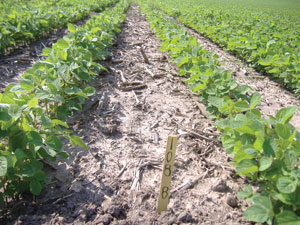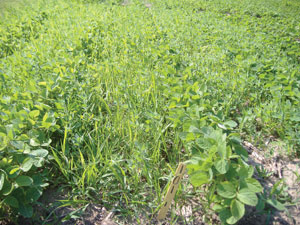
Features
Herbicides
Seed & Chemical
New herbicide for weed control in soybeans
Coming to Canada, it works for broadleaf and grass weed control in all types of soybean cultivation.
February 21, 2009 By Treena Hein
Herbicide resistance is a constant and pressing problem for soybean farmers, which is why the development and testing of new herbicides is an ongoing endeavour. “One of the key components to herbicide resistance prevention and management programs is the availability of a wide array of herbicides with different modes of action,” says Dr. Francois Tardif, associate professor in Plant Science at University of Guelph. “In Ontario since 1996, resistance to acetolactate synthase inhibitors (Group 2) has developed at a steady rate in many species. In addition, resistance to photosystem II inhibitors (Group 5) is still quite widespread.”
 |
| A test plot with Pursuit + Valtera shows the level of control provided. Photos courtesy of Valent Canada Inc. |
Flumioxazin, says Tardif, is a member of the protox inhibitor type of herbicides (Group 14) that offers new weed management options. “However, contrary to other Group 14 herbicides registered for soybeans in Canada,” he says, “flumioxazin is a soil-active pre-emergent herbicide, which means it provides both enhanced burndown and residual control.” The family of chemicals to which flumioxazin belongs works by inhibiting production of an enzyme important in the synthesis of chlorophyll.
Tardif observes that the availability to Ontario soybean growers of a herbicide containing flumioxazin would provide another weed management option and contribute to resistance prevention. Valent Canada Inc. based in Guelph, Ontario, has recently applied for registration of a flumioxazin-containing herbicide, which the company is hoping will be available for the 2009 season. Valent claims that Valtera promises control of “even the toughest broadleaf weeds” while also suppressing annual grasses in Roundup Ready and Glyphosate Tolerant soybeans as well as non-GMO and identity preserved (IP) beans.
Valent company studies have found Flumioxazin Technical, as it is referred to on registration forms, is practically non-toxic to bees and avian species. It is slightly to moderately toxic to fresh-
water fish and moderately to highly toxic to aquatic invertebrates. It does not present a genetic hazard.
 |
| The weedy check plot offers a glimpse of the weed pressure in these plots. |
Valtera should be applied as a pre-plant or early pre-emergent herbicide, from 30 days prior to planting up to three days after planting (before emergence). In burndown situations, it can be used as a foundation herbicide partner with glyphosate in Roundup Ready or glyphosate tolerant soybeans. In research, flumioxazin has been shown to increase the speed and consistency of the glyphosate burndown and to give about six weeks of residual control.
Flumioxazin degrades rapidly in water and soil. The molecules present after degradation are incorporated into soil organic matter and carbon dioxide. Regina Rieckenberg, sales and marketing manager with Valent Canada, says “Based on column leaching studies and the short aerobic soil half-life, the potential for flumioxazin or its degradation products to leach in field agricultural soils is low. The low use rate and rapid soil dissipation results in low carryover potential to rotational crops.”
Testing details
Tardif tested Valtera during the summer of 2008. He says “I have found it effective in controlling many dicot weeds that demonstrate Group 2 resistance such as common lamb’s quarters, green and redroot pigweeds and eastern black nightshade. I could envision Valtera being used in a tank mix with metribuzin, metolachlor or imazethapyr to broaden the spectrum of weeds managed in IP soybeans. It would also fit well with glyphosate products and help prevent glyphosate resistance in Roundup Ready systems.”
Research on Valtera also has been conducted by Dr. Peter Sikkema, professor of field crop weed management at the University of Guelph, Ridgetown Campus, and Mike Cowbrough, weed management lead for field crops with the Ontario Ministry of Agriculture, Food and Rural Affairs (OMAFRA).
Cowbrough says “During the 2008 growing season, I had the opportunity to evaluate flumioxazin treatments in a University of Guelph/OMAFRA research project. By comparing all of the standard conventional herbicide programs for weed management, I sought to identify consistently effective herbicide treatments in IP soybeans.” He adds “We were addressing the difficulty Ontario soybean producers are having with resistant weed species, namely lamb’s quarters, pigweed and eastern black nightshade. Poor control of these weeds significantly reduces soybean yield and has caused quality issues, such as seed staining, which reduces the grade of the crop and the financial premiums associated with this specialty food grade crop.”
One of the trial locations in 2008 had significant populations of Group 5 and Group 2 resistant lamb’s quarters and pigweed species. “Due to this spectrum of weeds, the majority of herbicide programs currently in the Ontario marketplace failed to adequately control these weed populations. The only herbicide treatments that effectively managed these resistant weed populations contained the active ingredient flumioxazin,” says Cowbrough. “The registration of flumioxazin would address a number of deficiencies for management of herbicide resistant weeds in Ontario soybean production.”
Rieckenberg adds “The flumioxazin compound in Valtera has a long, proven history in the US against weeds such as Eastern black nightshade, which is a significant problem across several American states. In various trials in southern Ontario in 2008, Valtera showed as much as much as eight weeks’ control on Eastern black nightshade and pigweed, and six weeks’ control on lamb’s quarters, Canada fleabane, three seeded mercury and velvetleaf.
Both this broad spectrum control and extended length of residual control are attributes that set Valtera apart, says Rieckenberg. “Valtera will not only effectively control tough weeds, but will give Canadian soybean farmers a good rotational tool to help manage future resistance issues.”